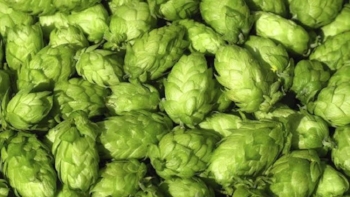What four primary ingredients are used to make beer?
Though used in varying proportions depending on the style being made, ALL beer is made from grain, hops, yeast, and water.
Grains
The grains (barley, wheat, rice, corn, oats, rye, etc.) are much the same as those that are used to make many breakfast cereals. The barley and wheat must undergo a malting process before they can be used to make beer (the others do not). The malting process simulates grain germination, which metabolizes the natural grain sugars (called maltose), which is what the yeast feeds on during fermentation. To do so, the seed is soaked in water until the plant starts to grow. Just before it emerges from the seed it is put in a kiln and dried. The method of drying can make different colors and flavors of malt.
Grains give beer three important qualities:
Malt Flavor and Aroma – These range from gently corn-like to burnt and mocha-like, with many points in between.
Color – This determined by the type of malt used. All beers are made from a large proportion of light-colored malts, because they have special chemicals, called enzymes, which convert malt starch into sugar.
Fermentable Material – Meaning the “food for the yeast.” Sugars derived from the malt provide all of the food that yeast will consume and convert into alcohol and carbon dioxide.
Hops
Hops provide beer with piquant aroma, a variety of flavors, and a delicate-to-intense bitterness that balances the sweetness of the malt. They are the flowers of a perennial vine resembling soft, green pine cones and contain a yellow powder called lupulin. The resins and oils contained in this powder are vital for beer making.
A hop resin called alpha acid gives beer its bitterness. The oils give certain beer styles, like pale ales, their floral, citrusy, hoppy aromas.
When hops are boiled, the alpha acid undergoes some chemical changes that allows it to bitter the beer. The less time the hops are boiled, the less bitterness in the beer.
There are many different hop varieties, just as there are different kinds of tomatoes. Each variety has a flavor and aroma of its own.
Yeast
Yeast is the third major ingredient in beer. During fermentation, yeast consumes the sugars derived from the malted grain and excretes ethyl alcohol and carbon dioxide in return.
There are two major categories of brewing yeast: ale yeast and lager yeast. There are hundreds of different yeast strains within these categories. Certain strains are suited to making specific beer styles. Some brewers believe the yeast used in the most important element in determining their beer’s character.
Most yeasts, even other ale yeasts, tend to be more neutral in character than yeast strains used to make Bavarian-style wheat beers. Lager yeasts are the most neutral of all the strains, producing fewer fermentation by-products, thus allowing the malt and hop character of the beer to dominate the palate.
Water
Considering that beer consists of up to 95% water, the quality of the water is of great importance. Depending on its source, water can have varying levels of mineral content, and which can have a significant effect on the taste of the beer.
In days past, it was not possible to alter the mineral content of a region’s water, which gave water a tremendous influence over the beer styles that could be successfully produced in the area. This has shaped the evolution of regional beer styles.
For example, Stouts are associated with Dublin, Ireland, because in a time when water was untreated, it was only suitable for dark beer production. English-style pale ales, made famous at Burton-on-Trent in England, owe their unique hop bite to the high sulfate content of the region’s water. Whereas, in southern Germany (Bavaria), the high carbonate content of the water demanded that beers be dark and relatively low in hop bitterness.
That’s it! In the hands of a skilled brew master these four simple ingredients can be transformed into a unique work of brewing art. There are hundreds of beer styles, thousands of breweries and tens of thousands of unique beers – all generated from these simple ingredients. The ever increasing number of new brewers are pushing beer creativity to new heights. With the addition of other ingredients – like spices or fruits – the flavor combinations are endless. As brewers continue to innovate, the future, for beer drinkers, is very good. Cheers!



